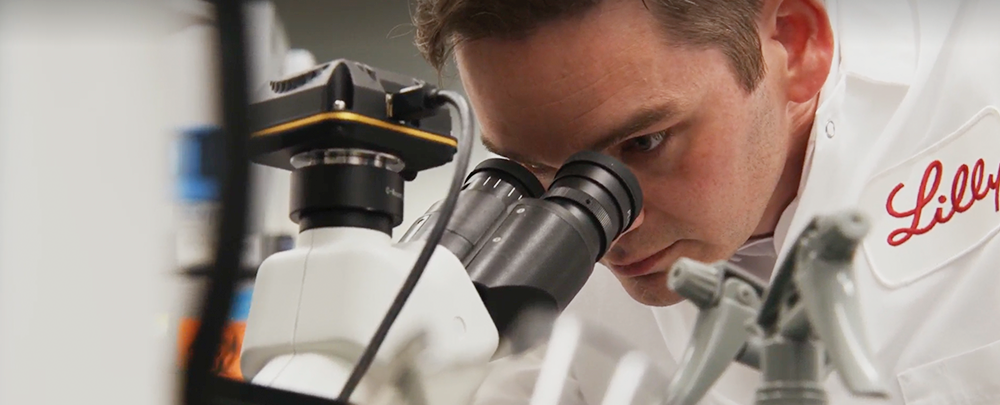Understanding Genetic Medicines: Debunking Common Misconceptions with Andrew Adams
March 20, 2023 Posted by: Eli Lilly and Company

It has been two decades since the Human Genome Project successfully unlocked the road map of what makes us “us.” The sequencing of the human genome1, mapping the genes that make up a human, was a 13-year effort, and this breakthrough, coupled with tremendous advances in technology, has brought forth a new frontier in medicine. We can now pinpoint the genetic causes of diseases in ways that will not only help us find treatments—but lead us to potential cures.
Despite a growing understanding of genetics, there are many misunderstandings about genetic medicines and how they work. Andrew Adams, PhD, co-director of the Lilly Institute of Genetic Medicine and senior vice president of Genetic Medicines and Neurodegeneration Research explains some of the most common misconceptions, and why patients should be hopeful about the potential benefits these therapies can offer.
Did you know that genetic medicines have been widely researched for several decades?
Genetic medicines are often thought of as a new form of therapeutic. However, it has been over 50 years since the initial idea of using genetically engineered treatments took hold2 and over 30 years since the first clinical trials studying the use of gene therapies began3. In fact, since the early 1990s, more than 1,900 clinical trials have been conducted studying genetic causes of diseases. In this period, we have seen application of potential gene therapies in a wide range of diseases, including certain cancers, neurodegenerative diseases, metabolic and cardiovascular diseases.3
Dr. Adams: “For decades, scientists and researchers have been investigating the development and utilization of genetic medicines to treat diseases. With recent advancements in biotechnology and a deeper understanding of the human genome and its connection to disease, we as an industry have been able to make significant progress. In addition to a large number of potential therapeutics advancing in clinical development, there are several approved genetic medicines in use today.”
Did you know that genetic medicine doesn’t narrowly focus on making permanent changes to one’s DNA?
While some people think genetic medicines involve permanently altering a person’s DNA, this is only one way we can apply the technology. In reality, genetic medicines allow us to target specific processes that contribute to the underlying cause of diseases in diverse ways, which often doesn’t require permanent changes.
Dr. Adams: “Genetic medicines may provide substantial benefits for people suffering from diseases with a known genetic driver. This includes a number of rare diseases like sickle cell disease, hemophilia and certain types of amyotrophic lateral sclerosis (ALS), but also potentially for more common chronic diseases like Alzheimer’s disease.”
Did you know that, despite challenges, the potential benefits genetic medicines may provide are within reach?
The delivery of genetic medicines is difficult because we must ensure the therapy is delivered to the correct place (e.g., the liver), with the correct genetic code to only make the change we intend. It is these challenges of delivery and specificity that occupy much of our scientist’s time today.
Dr. Adams: “Obstacles are present in almost every class of drugs. Groundbreaking therapies that we accept as standard today were advanced only after perseverance through disappointments and challenges. Figuring out the best way to deliver genetic medicines to the patient is critical to the success of these treatments and is a significant problem today, however, it’s a problem which I feel we are on the precipice of cracking. With success in delivery, we will be one step closer to achieving the ultimate goal— generating transformational medicines for patients.
At Lilly, for example, we are studying a method of delivery for genetic medicine using nanocarriers. These are incredibly tiny delivery vehicles which, because of their small size, can take therapies to otherwise inaccessible places in the body. By using nanoparticles to deliver our treatments, it’s possible that we can enable the ability to dose a patient multiple times until a sufficient therapeutic threshold is reached and maintained —all while avoiding unwanted immune responses. In ALS, these delivery vehicles hold the promise to allow us to take many new kinds of medicines, such as gene therapies and genetic editors, to the neurons in the brain and spinal cord which drive the disease.
When we are able to successfully deliver therapies, we may be able to provide significant benefits to patients living with diseases that today lack sufficient standard of care. With nearly 6 in 10 adults in the United States living with at least one chronic disease,4 the benefits these therapeutics may have on society could be significant—and I am hopeful for what genetic medicines may be able to bring to patients in the future.”
Learn more about our work to advance genetic medicines and hear about the hope for the possibilities to come in a video produced for us by BBC StoryWorks below.
The Potential of Genetic Medicine
1. Nurk, S., Koren, S., Rhie, A., Rautiainen, M., Bzikadze, A. V., Mikheenko, A., Vollger, M. R., Altemose, N., Uralsky, L., Gershman, A., Aganezov, S., Hoyt, S. J., Diekhans, M., Logsdon, G. A., Alonge, M., Antonarakis, S. E., Borchers, M., Bouffard, G. G., Brooks, S. Y., … Phillippy, A. M. (2022). The complete sequence of a human genome. Science, 376(6588), 44–53. https://doi.org/10.1126/science.abj6987
2. Friedmann, T., & Roblin, R. (1972). Gene Therapy for Human Genetic Disease? Science, 175(4025), 949–955. https://doi.org/10.1126/science.175.4025.949
3. Tamura R, Toda M. Historic Overview of Genetic Engineering Technologies for Human Gene Therapy. Neurol Med Chir (Tokyo). 2020 Oct 15;60(10):483-491. Doi: 10.2176/nmc.ra.2020-0049. Epub 2020 Sep 8. PMID: 32908085; PMCID: PMC7555159.
4. Chronic Diseases in America | CDC. (n.d.). https://www.cdc.gov/chronicdisease/resources/infographic/chronic-diseases.htm